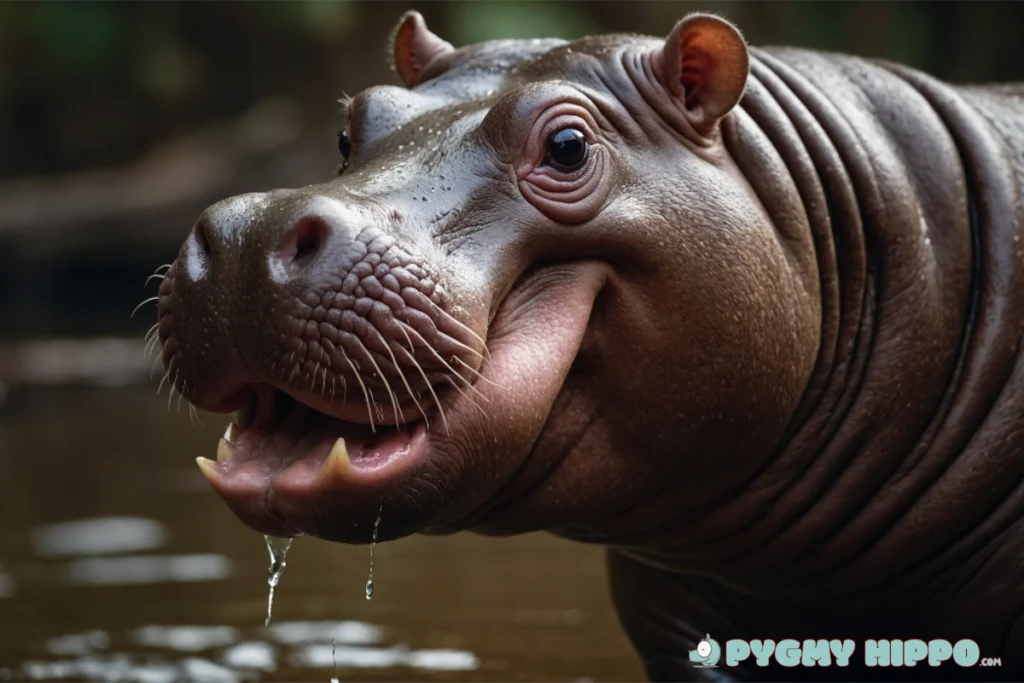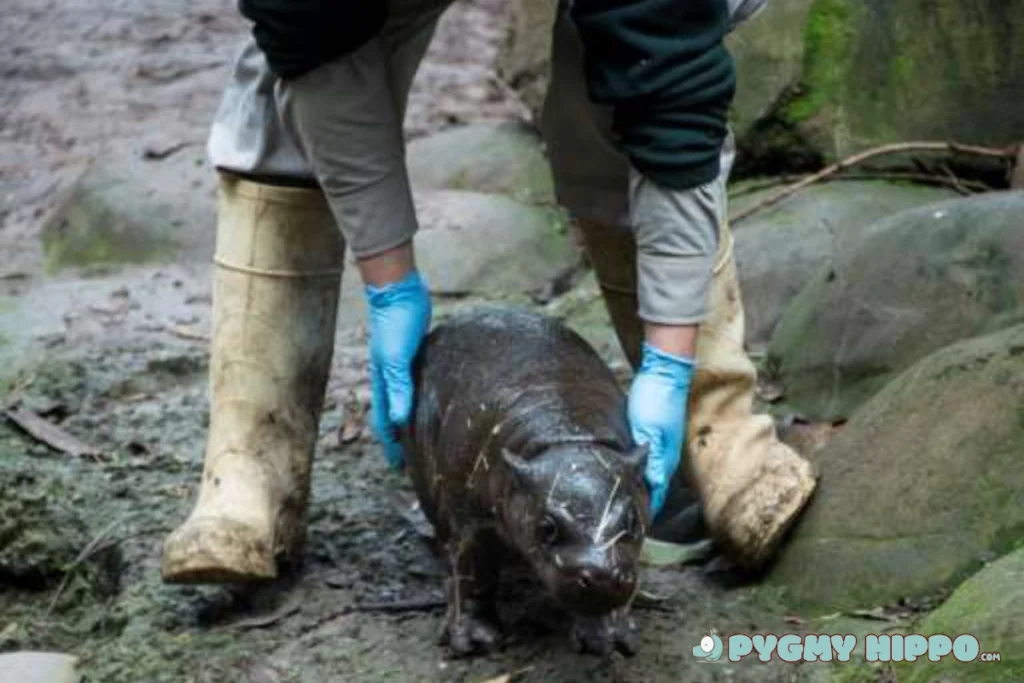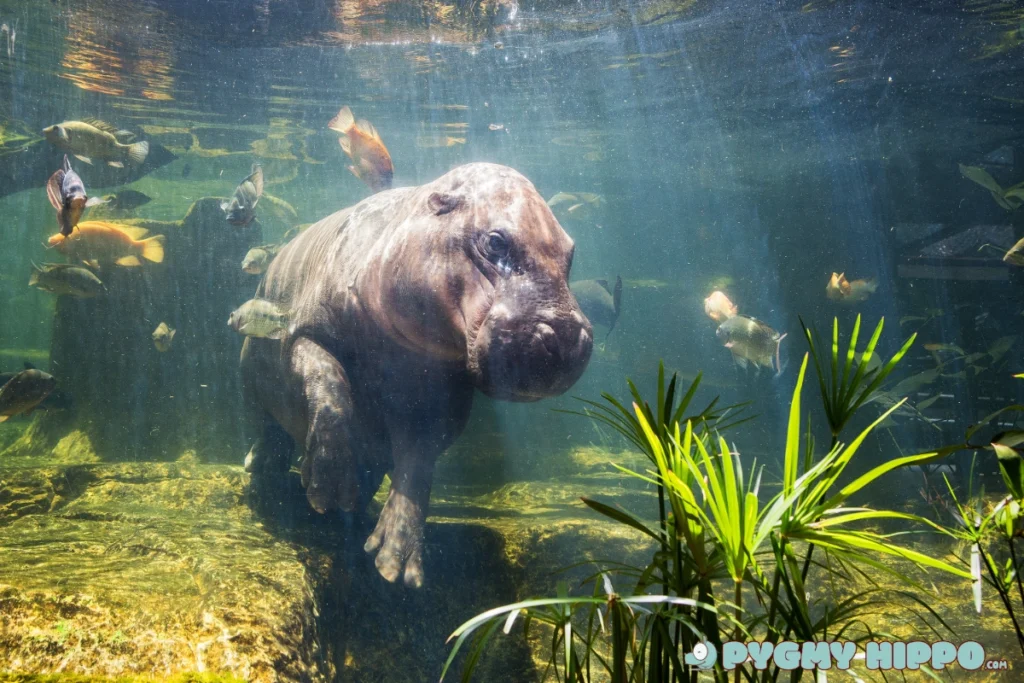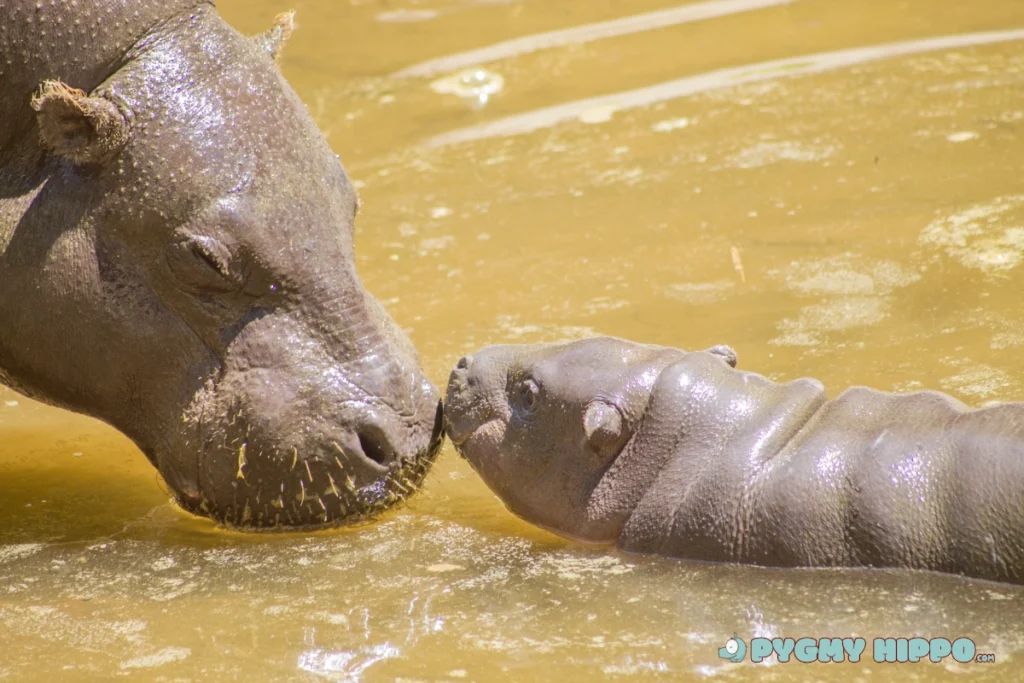Pygmy Hippo
The Pygmy Hippo is a real, remarkable, elusive, and endangered resident of the dense forests and swamps of West Africa. At full-size 375lbs (170kg) – about the size of an adult pig the pygmy hippo is only a fraction of the size of its cousin the common hippopotamus which weighs between 3000-4000lbs. Unlike its larger relative, the Pygmy Hippo is less aquatic but shares a similar dependence on water for hydration, skin protection, and thermoregulation. Despite these and other stark differences in anatomy and ecology, the pygmy hippo and the common hippo share the same taxonomic family Hippopotamidae. The pygmy hippo’s secretive, nocturnal habits make it a difficult though fascinatig subject of study.

There is some debate about the correct taxonomic classification of the pygmy hippo, with some believing it should be name Hexaprotodon liberiensis and others who believe Choeropsis liberiensis is the accurate name. To add to the confusion, there is an even smaller subspecies, C. liberiensis heslopi, which historically inhabited forests in Nigeria, though zoologists fear it now extinct in the wild. See our article with more details about the pygmy hippo classification debate here.
Pygmy Hippo Physical Characteristics
The Pygmy Hippo stands as a distinct entity among the hippopotamidae family, with adults measuring about 150-175 cm in length and weighing between 180-275 kg. Their skin is dark brown, thick, and notably secretes a pinkish fluid that serves as a natural sunscreen and antiseptic. This adaptation is crucial for their survival in the humid and sun-exposed habitats of West Africa.

Compared to the common hippopotamus, the Pygmy Hippo exhibits several anatomical differences tailored to its forested environment. Its legs are proportionally longer, and the head is less massive, features that facilitate maneuverability through dense vegetation. Furthermore, their eyes, ears, and nostrils are positioned on top of the head, an adaptation for their semi-aquatic lifestyle, allowing them to breathe and observe while submerged.
Living deeply secluded within dense rainforest interiors requires unique specializations. For example, skeletal analysis reveals shortened, ridged skull bones over enlarged sinuses in pygmy hippos compared to river-dwelling hippos. This adaptation lightens the skull for easier movement through their inclined forested habitat. Researchers likewise discovered the pygmy hippo’s digestive system differs from the common’s, being better suited for processing fruits and leaves versus aquatic vegetation. This shows evolution shaped its petite form specific to thriving in forest ecosystems versus open floodplains.

Similarly, shoulder height and more angular limb positioning allow pygmy hippos greater agility traversing through tangled underbrush and wooded slopes versus common hippos built to propel through water. They also retain sharp lower canines for stripping foliage versus common hippos’ mostly blunt teeth optimized for grazing grasses. Fern diets demand different dentition after all! Their nocturnal nature also sets pygmy hippos apart as they avoid overheating under a dense jungle canopy. Camouflaging skin patterns and behaviors add additional rainforest survival advantages.
Habitat and Distribution
The Pygmy Hippopotamus is native to the forests and swamps of West Africa, with a primary distribution in Liberia, and fragmented populations in Sierra Leone, Guinea, and the Ivory Coast. Their habitat is characterized by dense forests near water bodies, where they can easily access their aquatic environment for feeding, mating, and refuge from predators.
The distribution of the Pygmy Hippo is closely linked to the availability of these habitats, which are increasingly under threat from deforestation, agriculture, and human settlement expansion. This spatial limitation has profound implications on their behavior, forcing them into nocturnal patterns to avoid human contact and competition for resources.
Pygmy Hippo Behavior
Living deep within the shaded, watery environment of tropical forests provides pygmy hippos effective camouflage from predators like leopards. Their smooth brown-gray skin blends with vegetation while swirling white markings mimic light playing on leaves. Remaining hidden aids their survival, since pygmy hippos are slower runners than most African wildlife. They rely on stealth and secretiveness versus speed. If threatened, these heavy hiders will flee rapidly across their network of trails into thick cover or water deep enough to totally submerge their bodies and observe threats from below.
As largely solitary, territorial creatures active mostly at night, observing pygmy hippos scientifically in the wild proves extremely challenging. But study of both wild and captive subjects has allowed researchers to gather enough information to draw meaningful conclusions about many fascinating facets of the pygmy hippo’s secretive lives.
A pygmy hippo starts its day just before dusk, emerging cautiously from a hollowed out forest nest. With those stumpy legs, it can’t wander too far. Pygmy hippos beat distinct trails connecting preferred fruiting trees, marshes, mineral licks, and resting spots within territories stretching about 3⁄4 square mile. As highly territorial and solitary creatures, pygmy hippos aggressively guard these zones − using low growling vocalizations or intimidating charges if rivals approach.
After a night of browsing leaves, ferns, berries and fallen fruits, pygmy hippos spend their days cooling off while secluded in hollow trunks, thickets or muddy wallows, eventually dozing off. Falling asleep helps avoid the hottest afternoon hours. Some may leave their day nest to feed again briefly before dawn. Pygmy hippos have no strict schedule, simply sticking near their home range while alternating eating, resting and brief bursts of activity. Their high fruit diet definitely fuels constant snacking!
Vocalizations number over 18 distinct calls including warning cries, aggression signals and mating invite rumbles facilitating rare meetings for reproduction and alerting others to avoid territorial disputes. Such wide vocal repertoires imply deeper social systems at play worthy of further scientific investigation in coming years to better understand their communications.
Reproduction and Lifespan
Compared to large hippo groups noisily congregating along rivers, pygmy hippos quietly keep to themselves. How do these solitary creatures find each other to mate then? Males appear able to sense when a female hippo in their vicinity goes into heat based on chemical signals. He will pursue her determinedly until she allows him near. After a courtship of whining vocalizations and chasing through their adjoining home ranges, mating happens either on land or partially submerged in water holes.

The gestation period lasts 6-7 months, after which the mother pygmy hippo gives birth to a single tiny calf. Newborns weigh just 4-6 lbs 6-14 kg. They mature slowly, taking 5-7 years to reach adult size. In the wild pygmy hippos live about 30 years. Captive hippos generally have longer 40+ year lifespans. Parent pygmy hippos show an intriguing amount of care given the species largely solitary ways. Mothers hide newborns within isolated forest nests for the first few weeks to guard against predation before gradually introducing them to suitable habitat as they grow.
Reaching reproductively maturity around five years old, mating occurs on land or in water with very sparse courtship rituals. Gestation lasts six to seven months typically yielding single births. Beyond nursing which lasts 6-12 months, interactions between widely dispersed pygmy hippos remains limited outside mating encounters. Yet mothers exhibit extensive parental care uncommon for solitary species, hiding newborns in remote forest nesting sites then later introducing them to prime feeding grounds as juveniles. They tolerate offspring lingering within their range for over two years until mature enough to disperse locate their own territories.
Intriguingly, beyond mother-young bonds, researchers gleaned pygmy hippos can still recognize various individual hippos they encounter. Though they intentionally avoid contact when possible, males especially still exhibit extensive knowledge of their neighbor’s ranging habits, likely useful for optimizing mating chances when estrus females roam near territorial boundaries. This hints complex social dynamics occur despite an overall solitary social structure.
In the wild, Pygmy Hippos can live up to 30-40 years, though this can extend up to 50 years in captivity, where threats from predation and habitat loss are mitigated. Their reproductive behavior, combined with their longevity, is crucial for the survival of this species, albeit challenged by the current environmental threats.
Pygmy Hippo Ecology
Despite their name linking them to larger hippo relatives, pygmy hippos fill a distinct niche within Africa’s rainforest ecosystems. Their small size and forest adaptation allows them to traverse dense underbrush to access fruiting trees and patches of ferns or leaves unavailable to ground-dwelling grazers.
As herbivores, pygmy hippos feed on a diverse mixture of rainforest vegetation. The bulk of their diet consists of leaves, ferns, aquatic plants and fallen forest fruits they forage for nocturnally. Fruits with softer outer coverings and higher nutrient content seem preferred whenever in season. To ingest adequate minerals, pygmy hippos supplement plant matter by visiting salt licks. Their versatile digestive system and sharp lower teeth suit this wide-ranging diet.
In terms of natural predators, their isolated forest habitat and nocturnal activity affords pygmy hippos relative safety compared to plains-dwelling megaherbivores. Main predators like leopards or crocodiles usually only pick off stray young or sick individuals. Healthy adults easily scare off threats or flee to water or nests to hide using their speed and intimidating jaws to defend themselves if needed.
While pygmy hippos are solitary and thus limited seed dispersers, their selective fruit preferences and trailing habits still facilitate some forest regeneration. Their small grazing ranges centered on fruit trees creates feedback loops that help certain tree species thrive. Pygmy hippos also foster channels of marshy habitat via regular use of watery wallows for cooling and protection. So while elusive, these mini hippos fill a vital ecological role by continually pruning and circulating rainforest plant life. Protecting pygmy hippo habitat equals preserving the health of central Africa’s entire wet tropical forest communities.
Pygmy Hippo Conservation Status and Efforts
The Pygmy Hippo is classified as Endangered by the International Union for Conservation of Nature (IUCN), with an estimated population of fewer than 3,000 individuals in the wild. The primary threats to their survival include habitat loss due to deforestation. Intensified hunting for bushmeat and human encroachment likewise threaten pygmy hippos across what remains of their geographic range. Villagers view pygmy hippos as dangerous bush pests that can damage crops.
Late emerging reproductive maturity hinders rapid repopulation as well. Precise wild population estimates prove slippery given the denseness and size of their rainforest strongholds. Yet researchers agree numbers catastrophically nosedived by over 90% since 1990. IUCN Red List deems their vulnerability high, listing C. liberiensis as Endangered.
Conservation efforts for the Pygmy Hippo are multifaceted, focusing on habitat preservation, anti-poaching measures, and captive breeding programs. Initiatives such as the establishment of protected areas within their natural habitat and international breeding programs aim to ensure the survival of this unique species. These efforts require international cooperation and sustained commitment to address the complex challenges facing the Pygmy Hippo.
Without direct protection initiatives aimed at far larger, charismatic megafauna, these small, obscure creatures become collateral damage amid widespread logging, agriculture and bushmeat overhunting across their limited range. Zoos now prioritize captive breeding programs seeking to buoy vulnerable genetics until suitable forest conservation plans develop. But these rare gems of Africa’s dense forests remain dangerously close to the brink as human encroachment accelerates faster than sympathy or initiatives emerge for their salvation.
The Future Of The Pygmy Hippo
Increased scientific focus on the nuances of pygmy hippo sociality, reproduction, and spatial ecology is helping to build a richer understanding of how to shape evidence-based protection policies before the pygmy hippo population hits a tipping point. Several West African governments now grant pygmies legal protection with fines for poaching amidst habitat protection proposals to conserve loss rainforest biodiversity strongholds.
Additionally, local wilderness areas actively invite researchers to study resident hippos and pilot community education on their ecological importance. Such knowledge and fostering human value for their perseverance sparks hope for captive bred hippos one day returning their wild kingdoms. There, maybe the peaceful creatures can again rule hidden hippo highways through virgin rainforest if habitat and hunting conflicts resolve. Perhaps this sphinx-like mammal shall retain its mysteries for new generations of curious zoology minds yet to come.
Conclusion
This exploration into the world of the Pygmy Hippo reveals a species of immense ecological importance and fascinating biological adaptations. Despite their elusive nature, the ongoing threats to their survival underscore the urgent need for conservation action. Through continued research and dedicated conservation efforts, there is hope for the preservation of the Pygmy Hippo for future generations to study and admire.
Frequently Asked Questions
Pygmy hippos reach about 5-6 feet long and weigh 275-375 pounds fully grown, almost 1/10 the size of their common hippo relatives.
Pygmy hippos are found in rainforests and swamps in western Africa, mostly confined to countries stretching from Liberia to Nigeria
Pygmy hippos are herbivores, feeding on ferns, leaves, fruits, and other forest vegetation. They are mostly nocturnal while foraging.
Yes, pygmy hippo populations have declined over 90% since 1990 primarily due to habitat loss, hunting, and human encroachment. They are classified as Endangered.
Beyond their smaller size, pygmy hippos have adaptations for climbing sloped forest terrain, different dental and digestive systems, and more advanced parental care of offspring.
As solitary, nocturnal inhabitants of remote, dense rainforests in Africa, pygmy hippos are very difficult for scientists to consistently observe and study in the wild. Much of their behavior remains a mystery.
No. Pygmy hippos are solitary and will avoid contact with humans and other animals, though they are unpredicatable as any other wild animal when cornered or otherwise threatened.
Check out 10 amazing facts about pygmy hippos.